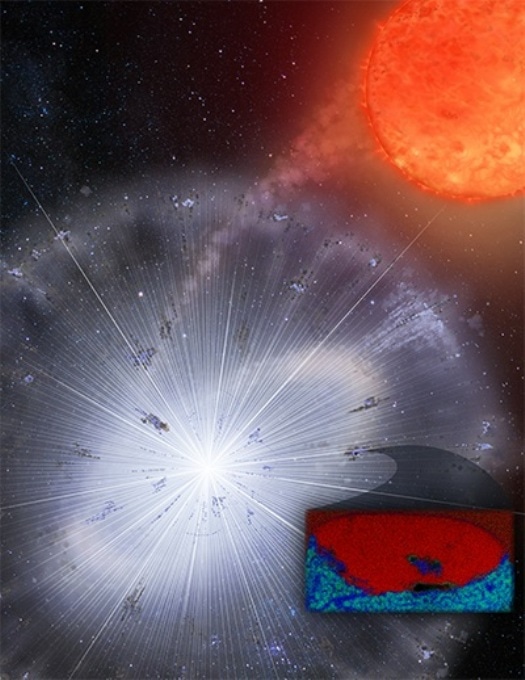Apr 30 2019
New insights into the formation of planetary systems have been given by the study of a tiny grain of stardust, the age of which is greater than the solar system.
 A team of researchers found a grain of stardust (inset image) that survived the formation of our solar system and analyzed it with instruments sensitive enough to identify single atoms. Measuring one 25,000th of an inch, the carbon-rich graphite grain (red) revealed an embedded speck of oxygen-rich material (blue), two types of stardust that were thought could not form in the same nova eruption. (Image credit: University of Arizona/Heather Roper)
A team of researchers found a grain of stardust (inset image) that survived the formation of our solar system and analyzed it with instruments sensitive enough to identify single atoms. Measuring one 25,000th of an inch, the carbon-rich graphite grain (red) revealed an embedded speck of oxygen-rich material (blue), two types of stardust that were thought could not form in the same nova eruption. (Image credit: University of Arizona/Heather Roper)
The microbe-sized extraterrestrial particle originated as a result of a nova explosion over 4.5 billion years earlier and was found within a meteorite collected by the National Aeronautics and Space Administration (NASA) in Antarctica.
Last year, atomic-level investigations of the grain were performed by Professor Jane Howe (MSE, ChemE), in collaboration with planetary scientists at the University of Arizona (UA), while she was a senior scientist at Hitachi High Technologies.
This grain is presolar. It originated before the formation of the sun. It’s just amazing to analyze such an anomaly.
Jane Howe, Professor, Department of Materials Science and Engineering, U of T Engineering
Howe and the team used sophisticated ion and electron microscopes to observe the arrangement of carbon atoms and its variants, called carbon isotope anomalies, and found that the presolar graphite grain consisted of oxygen-rich silicates—something they never anticipated to observe.
The observation of the team offers a new understanding of the conditions of a dying star. It is also contrary to the scientific theory that it is not possible for the two types of stardust material, carbon- and oxygen-rich—presolar building blocks for the formation of a solar system—to form in the same nova outburst, under similar conditions.
The outcomes of the study have been reported in the Nature Astronomy journal on April 29th, 2019, by the international alliance, including Howe, astronomers, planetary scientists, and material scientists at UA, Washington University in St. Louis, Polytechnic University of Catalonia in Spain, and Hitachi High Technologies in the United States and Japan.
“Sometimes research is about satisfying your curiosity. One of the greatest curiosities is how the universe was formed and how life started,” stated Howe. “And this weirdo particle showed us something we didn’t know before.”
Howe joined U of T Engineering in January 2019 and at present, she is using her electron microscopy expertise to investigate materials to develop renewable energy, as well as intends to widen her study to include meteoritic materials science research.
I thought this research project was really exciting, and I’m a curious person by nature. At the time, it was just part of my job assignment, but now it’s starting to become part of my research portfolio.
Jane Howe, Professor, Department of Materials Science and Engineering, U of T Engineering.
Howe plans to continue her partnership with scientists at UA. Moreover, recently, she started an alliance with U of T Professor Kim Tait (Earth Sciences), who is also the senior curator of mineralogy at the Royal Ontario Museum to investigate its collection of meteorites.
Furthermore, in September 2023, when the UA-led NASA OSIRIS-Rex mission returns to Earth after capturing carbon-rich samples of the asteroid Bennu, Howe will be part of the group of Canadian researchers to investigate its samples.
“This kind of research, it’s part of a much larger debate of how life started on Earth. We all care about who we are and where we came from,” stated Howe. “I’m so excited to be part of advancing our knowledge in this.”